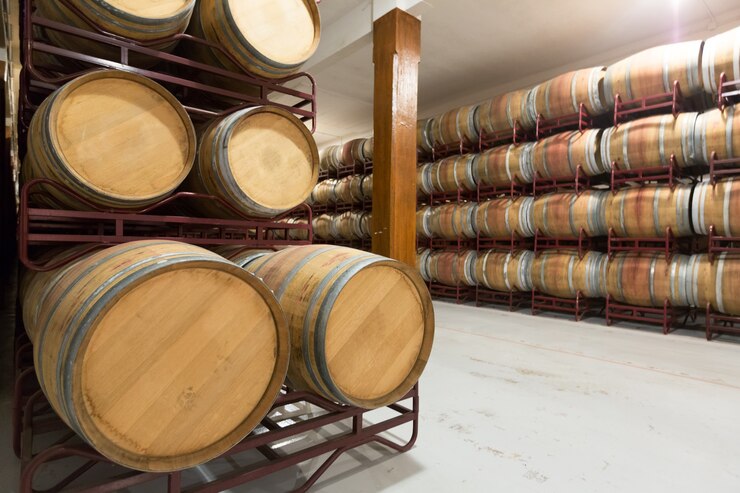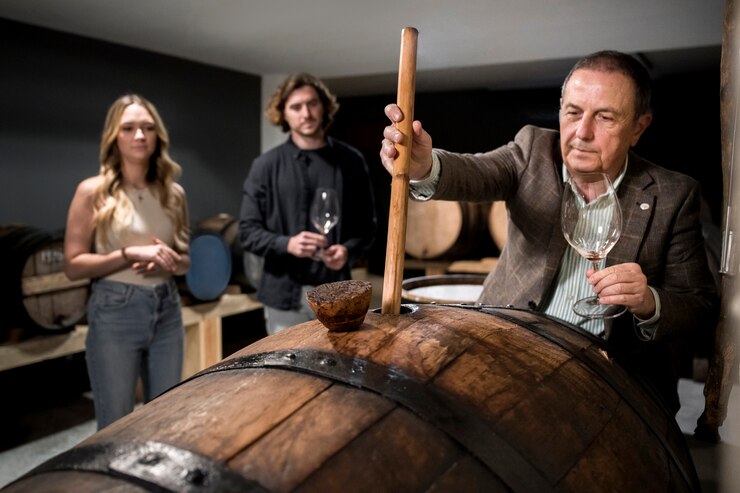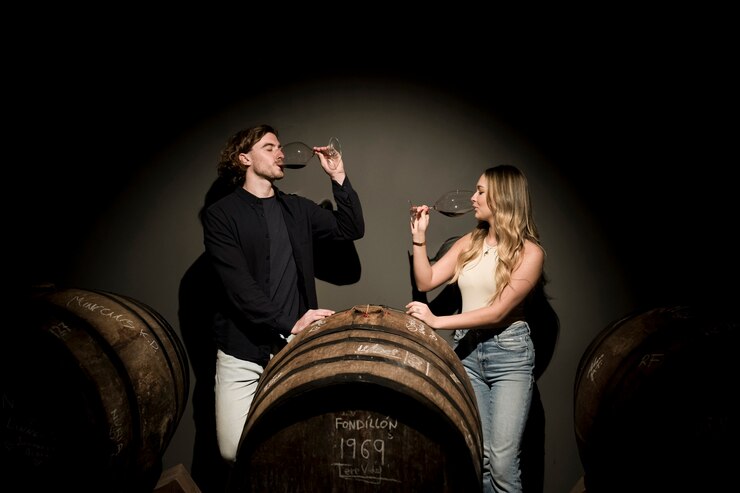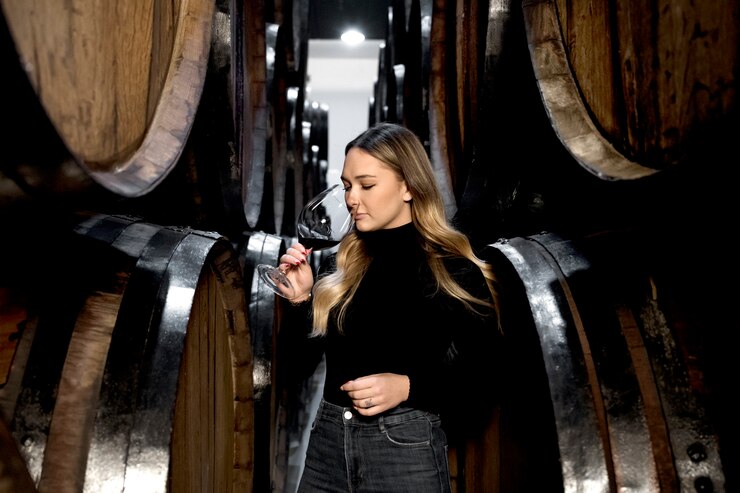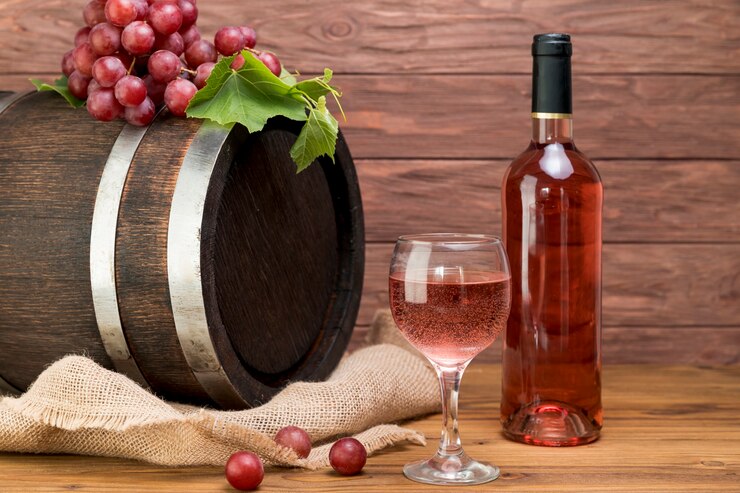What does Oak do to Wine?
Ever wondered why some wines taste like a cozy evening by the fireplace?
OR
A stroll through a scented forest?
It’s often the magic touch of oak!
Long ago, before fancy glass bottles came into the picture (we’re talking 1600s and earlier). Wines were stored in wooden barrels. Check out old paintings. And you’ll see wine barrels everywhere.
Although we no longer need barrels to store or move our wine. We have developed a liking for the oak wine flavour.
Let’s uncover the secrets of oak and wine. And understand why winemakers keep the tradition of wood wine.
The Beginning Of Oak and Wine
Oak and wine have been a long-time companion. Playing different roles throughout history.
In ancient times, the Romans used oak barrels for wine storage out of necessity. However, it wasn’t until the 1800s. when winemakers discovered that oak adds special flavours and complexity to wine.
Today, even though steel, plastic, and cement are used in winemaking. Many winemakers purposely choose oak for its unique effect on wine.
So, why is oak so vital in winemaking?
It’s more than just tradition. It’s about improving the taste. Adding character. And create a unique identity for each bottle of wood wine.
Oak brings out the best in wines.
What is Oaked Wine?
Oaked wine is a wine that’s been aged or made in oak barrels.
The wood adds flavours like vanilla and spice to the oak wine, changing how it tastes. The kind of wood, how big the barrel is, and how long the wine chills in there all change how the wine ends up tasting.
Winemakers choose different types of oak and how long the wine stays in the barrel to create unique flavours in the final product.
Is oak good in wine?
Yes Absolutely! Oak adds flavour to the wine. Like vanilla, clove, smoke, and coconut. It also makes the wine smoother and less harsh. All while creating a creamy taste.
How Does Oak Affect Wine?
So, What does oak do to wine? Oak works its magic on wine in three ways:
- Oak adds tasty elements like vanilla, clove, smoke, and coconut to the wine.
- It lets in a bit of oxygen slowly, making the wine smoother and less harsh.
- Oak creates important reactions. Like malolactic fermentation, making wines creamier.
Since winemakers can’t add flavour directly. They use oak for aging because they can’t add artificial flavours. Oak is their go-to for crafting the perfect taste.
Oak and wine when combined. Releases sugar that creates flavours like roasted, malty, and caramel notes.
Types of Oak
American and French oak are the main players.
- American oak is bold and budget-friendly.
- While French oak, the gold standard, brings subtlety but comes at a higher cost.
- Sometimes, winemakers mix the two for a perfect blend of flavours.
What is the best oak for wine?
There are two main types of oak used for aging wine. The American and French oak.
The American oak flavours in wine pack a punch. Giving bold flavours to oak wine. While French oak flavours in wine offer a subtler touch. Allowing the natural grape flavours to shine.
The choice depends on the winemaker’s vision and budget.
How oak influences wine?
The oak’s origin, drying process, toasting level, and even the barrel’s history all influence the final taste. Winemakers carefully choose these factors to create their desired flavour and texture.
Winemakers choose oak barrels based on various factors, including:
- Oak Origin: Where the oak comes from. (American or French)
- Drying and Toasting: How the oak is dried and toasted.
- Aging Time: How long the wine stays in oak.
- Barrel History: Whether the barrel has been used before. (Old oak and young oak)
Oak Barrel Size and Age Matters for Aging Wine
Barrel size and age matter too. Newer and smaller barrels have a more intense impact.
In simple terms, the age and size of the barrel decide how much the oak affects the wine. So, if winemakers want strong oak flavours. They need new barrels.
However, this choice comes at a cost.
Some smart producers age part of the wine in new oak to add flavour and complexity. Later, they blend oak wine with the rest aged in older oak. This creates a character-rich wine while saving on barrel cost.
What Does Oak Taste Like?
Oak in wine tastes like spice, leather, smoke, tobacco, caramel, and vanilla.
French oak gives a softer touch. Allowing the grape’s profile to shine. While American oak is more overpowering.
It’s not just about the type of oak. It’s also about how much the oak gets toasted. The toasting of oak barrels also adds different levels of toastiness to the wine.
Winemakers burn the insides of the barrels for varying times to achieve the desired level of toasty goodness in the oak wine.
| Oak and Wine Compound | Flavor Profile |
| Furfural | Dried fruit, burned almond, burnt sugar |
| Guaiacol | Burn overtones |
| Oak Lactone | Woody, dill, and coconut notes |
| Eugenol | Spices, cloves, and smoky vibes |
| Vanillan | Straight-up vanilla |
| Syringaldehyde | More vanilla-like goodness |
What type of wine is oaked?
Most reds enjoy some time in oak. Red wine with oak flavour includes Pinot Noir, Cabernet Sauvignon, Merlot, and Syrah.
Some white oak wine can benefit. But not all whites need that extra time. Like Pinot Grigio, Sauvignon Blanc, and Chardonnay.
| Red Oak Wines | White Oak Wines |
| 1. Pinot Noir | 1. Chardonnay |
| 2. Cabernet Sauvignon | 2. Viognier |
| 3. Merlot | 3. Sémillon |
| 4. Syrah/Shiraz | 4. White Rioja (Viura) |
| 5. Zinfandel | 5. Sauvignon Blanc |
| 6. Tempranillo (for some styles) | 6. White Bordeaux blends |
| 7. Malbec | 7. Chenin Blanc |
| 8. Nebbiolo (for some styles) | 8. Albariño |
| 9. Sangiovese (for some styles) | 9. Gewürztraminer |
| 10. Grenache (for some styles) | 10. Pinot Gris/Pinot Grigio |
How Oak Affects Red & White Wine
Red oak wines are rich with tannins and complexity. Benefit from time in oak. Smooth out rough edges and add flavours like smoke, spice, leather, or tobacco.
White oak wines are naturally bright and fruity. Hence, whites don’t need as much time in oak. However, some fuller white varieties like Chardonnay can embrace a buttery and spicy touch from oak aging.
How Long Does Wine Age in Oak Barrels?
The duration of wine aging in oak barrels depends on what the winemaker has in mind. Typically, it takes several months for the oak to start changing the wine.
Here are some common oak wine aging times:
| Wine Type | Aging Duration | Oak Type |
| Pinot Noir | 10 months | Old French Oak |
| Chardonnay | 13 months | 50% New French Oak |
| Gran Reserva Rioja | 24 months | 40% American, 60% French Oak |
| Zinfandel | 17 months | 20% New American Barrels |
Keep this in mind! These times can vary a lot among different producers and vintages.
It’s also worth noting that not all winemakers go the oak route. Some highly esteemed ones, like Chateau Petrus and Lafleur. Use alternative materials such as stainless steel and cement.
Pop Open Your Favourite Oak Wine Bottle
In winemaking, oak is the secret spice that adds depth, character, and complexity to your favourite bottle.
Whether it’s a hearty red or a crisp white. The influence of oak turns a simple grape by adding layers of flavour. So, the next time you sip on a glass of wine. Take a moment to appreciate the subtle notes of oak.
Cheers!
Ready for something special?
Don’t miss out on ‘The Premium Selection’ best oaks wine collection. Explore our wine catalogue and treat yourself today.


